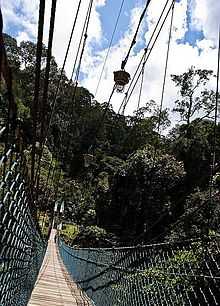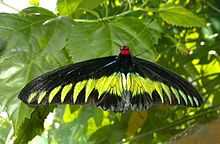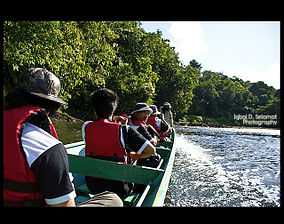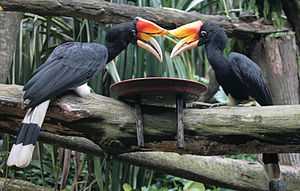Ulu Temburong National Park
| Ulu Temburong National Park Green Jewel of Brunei | |
|---|---|
|
Journey by long boat on Temburong River to Ulu Temburong National Park | |
 Location of Ulu Temburong National Park | |
| Location | Near |
| Nearest city | Brunei Darussalam |
| Coordinates | 4°28′41″N 115°12′28″E / 4.478°N 115.2077°ECoordinates: 4°28′41″N 115°12′28″E / 4.478°N 115.2077°E |
| Area | 212 square miles (550 km2) |
| Established | 1991 |
Ulu Temburong National Park was the first national park to be established in Brunei, protected since 1991. The park is in Temburong District in eastern Brunei, and covers about 40% of the district in the south at 550 square kilometres (210 sq mi). It is within the Batu Apoi Forest Reserve.[1] The park contains unspoiled jungle and is known as the "Green Jewel of Brunei",[2] described as "the finest example of the sultanate's successful forest protection policy".[3] The principal rivers are the Temburong and Belalong Rivers. It is an important ecotourism centre in Brunei and hosts the Ulu Ulu Resort.[4] The Peradayan Forest Reserve is also located in the district.[5]
Geography

Ulu Temburong National Park is situated in the extreme east of Brunei Darussalam, in the Temburong District. It is bounded by three other districts and the Sarawak state of Malaysia. It is a lowland rainforest covering an area of 212 square miles (550 km2).[2][6] [7] The park area is in the upper region of the eastern part of Brunei. The southern part consists of a hilly region with mountains rising to a height of 1,800 metres (5,900 ft) and the lowlands are in the northern slopes. The terrain is traversed by a number of rivers forming narrow valleys and includes the coastal region.[8]
The park, which can only be reached by river, is only accessed by longboats[9] from Brunei's capital city of Bandar Seri Begawan. The first destination by boat is Bangar town where the Limbang River emerges from Sarawak and drains into Brunei Bay with mangrove muddy deltas at the estuary. Travel from Bangar town to Batang Duri is by road and it is the starting destination for travel by longboats along the Temburong River into the Park. The boats are plied by experienced Iban people winding through sand bars, logs and boulders. An extensive network of boardwalks, bridges and stairways, 7 kilometres (4.3 mi) in length,[9] have been constructed to visit all regions of the park. Interpretation boards provide information along the way.[9] There is also a canopy viewing walkway. This walkway, built with steel towers supporting the cable way, rises to height of 50 metres (160 ft) above the forest floor overlooking the highest tree canopy and provides vistas of the forests.[6]
Flora
Vegetation in the reserve is in the form of tropical low forests with the Shorea, Dryobalanops and Dipterocarpus genera as the dominant species of plants. The primary lowland and upland forests are Dipterocarp forests, while the lowland montane forests are largely in the southern part. Mangroves are seen in the coastal areas.[6][8][10] Rattan species are also common at the ground level of the forests. Other common varieties noted in the forest are gingers, begonias, gesneriads, aroids, Ixora blooms. Along the river courses, the plants species noted are palms, ferns, mosses and lichens. Fruiting figs and geocarpic figs on which birds feed are also extensive.[6]
Fauna

Fauna include mammals, reptiles, butterflies and insects and birds.[6][10] The most popular, totally arboreal faunal species, is Müller's Bornean gibbon which is grey-brown in colour and is without tail. Its habitat is mostly the forest canopy and is occasionally seen at mid-canopy level.[6] Squirrels, in particular the tiny plain pygmy squirrel near human habitations, and black spotted rock frog (Staurois natator) are also reported from the park. Orchids and snakes, particularly the coloured Wagler's pit viper, reside on tree tops.[6]
The bushy-crested hornbill (Anorrhinus galeritus), rhinoceros hornbill (Buceros rhinoceros), broadbills, black-and-yellow broadbill (Eurylaimus ochromalus), and swiftlets are notable birds in the park.[6]
There are four hundred species of butterfly, some quite rare, and the most famous is the Rajah Brooke's birdwing which is given the name "white rajah" honouring James Brooke. The area was under his private authority as part of Sarawak during the colonial era; the male species have jet black wing colour and emerald green banding. Another variety of butterfly is the tree nymph (Idea stolli), which is a white and black spotted species. Other species of insects found are centipedes, giant forest ant (Camponotus gigas), lantern bugs and termites.[6]
Conservation
The park is under the control of the Forestry Department of the Ministry of Industry and Primary Resources. Offices of the National Park Headquarters are located near the confluence of Sungei Belalong with Temburong river. A research station was established and studies conducted on the forest ecology in the central Belalong area during the 1991-92 which proved the importance of wildlife and forest species in this park.[8] The park is part of the Heart of Borneo international conservation agreement.[11]
References
- ↑ USA IBP (25 November 2009). Brunei Mineral & Mining Sector Investment and Business Guide. International Business Publications. pp. 237–. ISBN 978-1-4330-0442-1. Retrieved 8 February 2013.
- ↑ 2.0 2.1 Thiessen, Tamara (1 January 2009). Borneo: Sabah, Brunei, Sarawak : the Bradt travel guide. Bradt Travel Guides. p. 145. ISBN 978-1-84162-252-1. Retrieved 3 February 2013.
- ↑ Ledesma, Charles De; Lewis, Mark; Savage, Pauline (1 December 2003). Rough Guide to Malaysia, Singapore & Brunei. Rough Guides. p. 596. ISBN 978-1-84353-094-7. Retrieved 3 February 2013.
- ↑ "Welcome to Ulu Ulu Resort". Ulu Ulu National Park Resort. Retrieved 3 February 2013.
- ↑ Rowthorn, Chris; Cohen, Muhammad; Williams, China (21 June 2008). Borneo. Lonely Planet. p. 233. ISBN 978-1-74059-105-8. Retrieved 3 February 2013.
- ↑ 6.0 6.1 6.2 6.3 6.4 6.5 6.6 6.7 6.8 Baker, Nick. "Ulu Temburong National Park- untouched rainforest of Brunei". Ecology Asia. Retrieved 7 February 2013.
- ↑ WWF 2012, p. 7.
- ↑ 8.0 8.1 8.2 WWF 2012, p. 22.
- ↑ 9.0 9.1 9.2 Font, Xavier; Tribe, John (2000). Forest Tourism and Recreation: Case Studies in Environmental Management. CABI. pp. 136–. ISBN 978-1-84593-303-6. Retrieved 8 February 2013.
- ↑ 10.0 10.1 "Ulu Temburong National Park the country’s first national park.". News Asian Biodiversity Organization. Retrieved 8 February 2013.
- ↑ Forestry Department of Brunei: The Heart of Borneo, retrieved 18 February 2013
Bibliography
- WWF (2012). "The Environmental Status 2012 of the Heart of Borneo Text" (PDF). WWF. Retrieved 8 February 2013.

